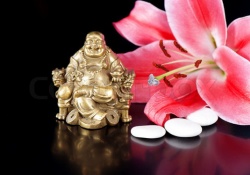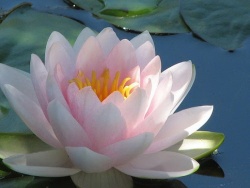Renge
renge
蓮華 ( Jpn; Chin lien-hua)
Lotus or lotus flower. Also called the Oriental lotus, Indian lotus, East Indian lotus or sacred lotus. An aquatic plant with flowers of white, pink, and other colors, often mentioned in Indian Buddhist scriptures and their Chinese translations. For example, in the Compassionate White Lotus Flower Sutra (Skt Karuna-pundarika-sutra; Jpn Hike-kyo), Shakyamuni Buddha is compared to the white lotus flower (pundarika), described in the sutra as a symbol of [[great
compassion]]. The white lotus flower, traditionally the most highly regarded variety, also appears in the Sanskrit title of the Lotus Sutra, Saddharma-pundarika-sutra. In his Chinese translation of that sutra, Kumara-jiva rendered the Sanskrit title as the Lotus Sutra of the Wonderful Law, or Myoho-renge-kyo in Japanese. Here pundarika is translated as lotus, or renge. Renge simply means lotus flower, without reference to the color or variety. The meaning of renge is of particular importance in Buddhist traditions deriving from the Lotus Sutra, such as those of T'ient'ai in China and Nichiren in Japan. Both interpret renge in various ways, examples of which follow:
(1) In The Profound Meaning of the Lotus Sutra, T'ient'ai (538-597) interprets the meaning of renge of Myoho-renge-kyo in two ways: as the figurative lotus and as the lotus that is the entity of the Law. He states, "Now the name renge is not intended as a symbol for anything. It is the teaching expounded in the Lotus Sutra. The teaching expounded in the Lotus Sutra is pure and undefiled and explains the subtleties of cause and effect. Therefore, it is called renge, or lotus. This name designates the true
entity that the meditation based on the Lotus Sutra reveals and is not a metaphor or figurative term." He then explains, "Because [the lotus that is] the essence of the Lotus Sutra is difficult to understand, the metaphor of the lotus plant is introduced." Here T'ient'ai refers to the three groups of voice-hearers portrayed in the Lotus Sutra and designated by their respective capacities: those of superior capacity understand the principle of the lotus directly, while those of intermediate and inferior capacities understand it only through its metaphor, the figurative lotus. T'ient'ai regards the parables of the Lotus Sutra as metaphors for the lotus that is the entity of the Law.
(2) In the same work, T'ient'ai refers to the two meanings of the lotus. The first regards the fact that the lotus grows and blossoms from muddy water. This, he says, symbolizes voice-hearers emerging from the muddy water of the lesser teachings and realizing, through the Lotus Sutra, that they are entities of the wonderful Law. Second, the lotus blooming symbolizes the Buddha revealing his pure and wonderful Dharma body in order to cause people to arouse faith. Thus, he is showing them the lotus that opens through a mystic cause.
(3) In The Profound Meaning of the Lotus Sutra, the figurative lotus is explained with three metaphors: the lotus blossom enfolding the fruit, the lotus blossom opening to reveal the fruit inside, and the lotus blossom falling and the fruit ripening. Each can be interpreted in two ways: First, from the perspective of the theoretical teaching (first half) of the Lotus Sutra, the three metaphors respectively mean that one cannot see the fruit of the true teaching because it is covered by the blossom of the provisional teachings; that
the blossom opens to reveal the fruit of the true teaching; and that the blossom of the three vehicles is replaced by the fruit of the one Buddha vehicle. Second, from the perspective of the essential teaching (latter half) of the sutra, the three metaphors mean that the blossom of the theoretical teaching contains the fruit of the essential teaching; that the blossom of the theoretical teaching opens to reveal the fruit of the essential teaching; and that the blossom of the theoretical teaching is replaced by the fruit of the essential teaching.
(4) Nichiren (1222-1282) refers to the lotus plant as symbolizing the simultaneous nature of cause and effect. In a letter to the lay nun Ueno, he states: "Thus there are all manner of plants, but the lotus is the only one that bears flowers and fruit simultaneously. The benefit of all the other sutras is uncertain, because they teach that one must first make good causes and only then can one become a Buddha at some later time.With regard to the Lotus Sutra, when one's hand takes it up, that hand immediately attains Buddhahood, and when one's mouth chants it, that mouth is itself a Buddha, as, for example, the moon is reflected in the water the moment it appears from behind the eastern mountains, or as a sound and its echo arise simultaneously" (1099).
(5)In The Entity of the Mystic Law, Nichiren states: "The Buddha who is the entity of Myoho-renge-kyo, of the 'Life Span' chapter of the essential teaching, who is both inhabiting subject and inhabited realm, life and environment, body and mind, entity and function, the Buddha eternally endowed with the three bodies—he is to be found in the disciples and lay believers of Nichiren. Such persons embody the true entity of Myoho-renge-kyo" (420).

